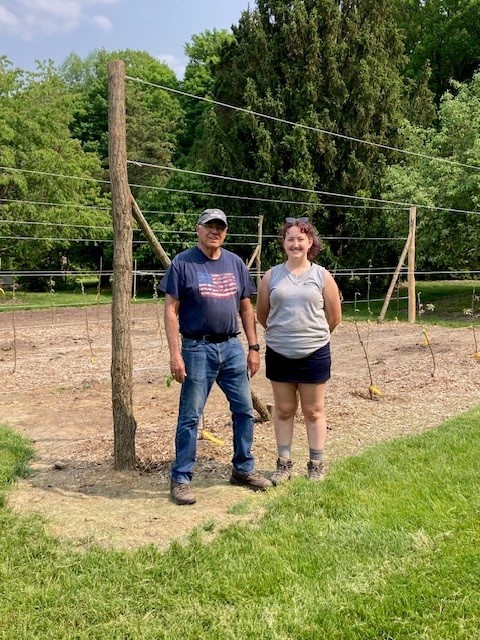Mawby Fruit Collection modernizes Apple Production System
Read about the apple production system in the C.E. Lewis Landscape Arboretum

The C.E. Lewis Landscape Arboretum established the Mawby Fruit Collection with the financial support of the Mawby family, long time Michigan fruit growers. Russ Mawby was a member of the MSU Board of Trustees. The 140 year old fruit industries in Michigan helped make the state second only to California in diversity of crop species. Plantings in the collection included an array of tree and small fruit species. The ever-evolving apple industry in Michigan is still strong. Commercial apple production orchards in Michigan have gone through a fifty-year transition of large trees spaced some 30-40 feet apart and 20-25 feet tall to today’s most popular system, the “Tall Spindle” system. Approximately, eighty to ninety per cent of Michigan and most northeastern apple industries today have adopted the Tall Spindle system (Figure 1).
In the late 1990s we established a small planting of high density apple trees, which reflected the current growing systems; the Slender Spindle and the Vertical Axe. The planting was removed in 2022 and replanted in the most popular system used in Michigan today; the “Tall Spindle”.
The Orchard Evolution. The older orchards remind us of days of “yester-year”, where farmers and their families picnicked under the shade of old apple trees. However, these older orchards took 6-8 years to come into production and required people to get up on tall ladders to prune and harvest the 25-foot-tall trees. Trees were planted at a density of 50 trees per acre and planted 30-40 feet apart. Then came the dwarf tree revolution, led by Michigan State University rootstock researcher, Dr. Bob Carlson, (Perry’s predecessor) who by way of the International Dwarf Fruit Tree Association, encouraged growers to begin using dwarfing rootstocks developed in Europe. The growers Fig. 1 abandoned the use of seedling rootstocks and the search for trees that were more manageable, bore fruit sooner and yielded more per acre. The new trees became smaller and came into production by the 2nd or 3rd growing season. The current most popular commercial apple production, “Tall Spindle” system, is a spin-off of the “Slender Spindle” training system developed and encouraged by Dutch researchers and the “Vertical Axe” system promoted by the French. Experimental systems included orchards planted at densities of over 2000 trees per acre.

The transition to the newer high density planting systems required growers to learn new management strategies where trees are planted 3-4 feet apart in-row spacing and 11 to 14 feet “alleyway” (across-row) spacing (1200 trees per acre). The newly planted Tall Spindle trees in The Mawby Fruit Collection are planted 4 feet by 19 feet to accommodate maintenance needs in the Arboretum. (Fig. 2).
We constructed a trellis support system using Black Locust wood (Fig. 3), donated by Flore Orchards, instead of the commercially used copper-treated round pine posts. Black locust (Robinia pseudoacacia), excels in hardness and durability, so pioneers cut it for fence posts. Historians found remains of buildings and black locust posts established by Jamestown colonists still standing after a few hundred years. Black locust wood was commonly used by shipbuilders, especially for constructing masts. Locust trunks contains mostly sapwood (xylem wood) making lumber strong. In drying, locust hardly shrinks and is stiffer than hickory and outlasts white oak. Rather than using the commonly used 12-gauge high tensile wire, we used a highly malleable nylon covered cable (1/16”) to support developing trees.
Trees on dwarfing rootstocks must be supported by a trellis system. Trees mature at 10 feet in height, trunks are small and there are no scaffold (permanent) branches commonly found in Slender Spindle and traditional Central
Leader (older system of growing apple trees). Tall Spindle trees are supported by a three or four wire trellis with other trees, on a M.9 or similar dwarfing rootstock (Fig. 1). Trees begin bearing as many as 15-20 fruit in the second growing season. Some of our research at Michigan State University demonstrated yields as high as 1000 bushels harvested per acre in the fourth or fifth growing season compared to the 250-300 bushels per acre not reached until the tenth growing season in the traditional older orchards. Most of the dwarfing rootstocks have brittle roots and they are poorly anchored on their own. Secondly, by virtue of gravity, heavy fruits bring small branches down, discouraging limb extension unlike the scaffolds on the large older traditional trees. Much of our current high density apple orchard systems derive from centuries old gardens in Europe using dwarfing rootstocks (Perry and Getter, 2021). The practice, known as Espalier can be seen in our current annuals gardens. Another benefit to the new high density planting systems is that not only do they begin production sooner, trees and orchards have a shorter life span than comparably large tree systems that last some 50-70 years. A shorter orchard life might appear a negative, but for the modern apple grower, it affords the enterprise the flexibility to change to contemporary varieties currently popular in the market. An example of this are the very popular apple varieties such as Honeycrisp and organically approved disease resistant varieties. Additionally, the narrow smaller canopy trees are more accommodating to mechanical equipment used to help prune and harvest trees.
Perry, Ron and Kristin Getter. 2021. Espalier Fruit Plantings for Northern Gardens; Creating Fruit Trees as Art. Amazon Kindle Books, ISBN 9780578870861, Electronic Book, P. 65. https://www.canr.msu.edu/hrt/our_gardens/Donate-to-the-Gardens/espalier-book.
Robinson, T.L. et. al. 2006. The Tall Spindle Apple Production System, New York Fruit Quartely, Vol 14(2); 21-28.



 Print
Print Email
Email
